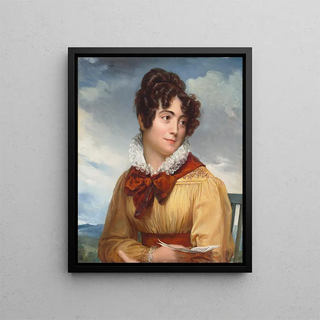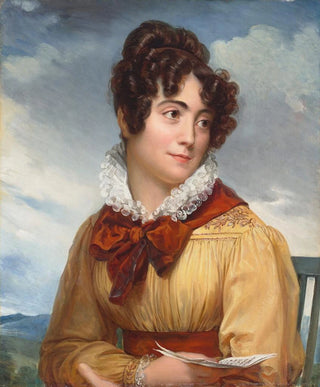Art print | Portrait of Alexandre Gérard, artist's sister-in-law - François Gérard


View from behind

Frame (optional)
The "Portrait of Alexandre Gérard, artist's sister-in-law" by François Gérard is a work that transcends the simple frame of a portrait to become a true window into the Romantic era. This painting, which captures the very essence of its subject, immerses us in a universe where finesse of line and brilliance of colors combine to offer a representation that is both intimate and majestic. Through this portrait, the artist does not merely paint a face; he tells a story, that of a woman who, through her gaze, seems to invite us to discover her inner world. This work, emblematic of its time, evokes deep emotions and connects us to a bygone era, while remaining strikingly modern.
Style and uniqueness of the work
François Gérard's style is distinguished by its delicate and refined approach, characterized by an exceptional mastery of light and shadow. In this portrait, every detail is carefully crafted, from subtle nuances of the skin to the sumptuous drapery of the sister-in-law's dress, which seem to almost vibrate under the light. Gérard uses a palette of soft colors, creating a warm and welcoming atmosphere. The gaze of his model, both thoughtful and engaging, captures the viewer's attention, inviting reflection on the thoughts and feelings that inhabit her. This ability to convey emotions through the gaze and facial expression is one of the artist's hallmarks, making each work an exploration that is both psychological and aesthetic.
The artist and his influence
François Gérard, born in 1770, is one of the most prominent portraitists of his time, distinguished by his skill in immortalizing emblematic figures of French society. His artistic career is marked by success, notably as Napoleon's official painter, which grants him considerable notoriety. Gérard draws inspiration from the old masters while incorporating innovative elements that mark the beginning of Romanticism. His influence is felt not only in his portraits but also in the way he approaches the representation of femininity.

Matte finish

View from behind

Frame (optional)
The "Portrait of Alexandre Gérard, artist's sister-in-law" by François Gérard is a work that transcends the simple frame of a portrait to become a true window into the Romantic era. This painting, which captures the very essence of its subject, immerses us in a universe where finesse of line and brilliance of colors combine to offer a representation that is both intimate and majestic. Through this portrait, the artist does not merely paint a face; he tells a story, that of a woman who, through her gaze, seems to invite us to discover her inner world. This work, emblematic of its time, evokes deep emotions and connects us to a bygone era, while remaining strikingly modern.
Style and uniqueness of the work
François Gérard's style is distinguished by its delicate and refined approach, characterized by an exceptional mastery of light and shadow. In this portrait, every detail is carefully crafted, from subtle nuances of the skin to the sumptuous drapery of the sister-in-law's dress, which seem to almost vibrate under the light. Gérard uses a palette of soft colors, creating a warm and welcoming atmosphere. The gaze of his model, both thoughtful and engaging, captures the viewer's attention, inviting reflection on the thoughts and feelings that inhabit her. This ability to convey emotions through the gaze and facial expression is one of the artist's hallmarks, making each work an exploration that is both psychological and aesthetic.
The artist and his influence
François Gérard, born in 1770, is one of the most prominent portraitists of his time, distinguished by his skill in immortalizing emblematic figures of French society. His artistic career is marked by success, notably as Napoleon's official painter, which grants him considerable notoriety. Gérard draws inspiration from the old masters while incorporating innovative elements that mark the beginning of Romanticism. His influence is felt not only in his portraits but also in the way he approaches the representation of femininity.






